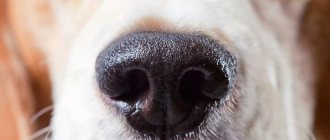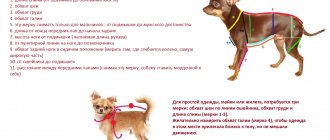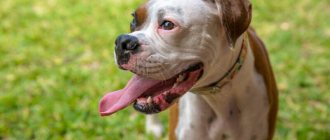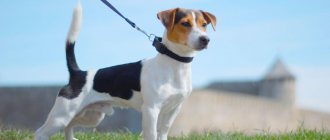A dog's temperament is a stable set of psychophysiological characteristics that underlies the formation of character and behavior. The dog's temperament is determined by the type of higher nervous activity. A dog's temperament is what it is born with and what largely determines its life. What types of dog temperament are there and how do they affect the process of training and raising a pet?
Photo: pixabay.com
Psychotypes of dogs
Dogs, just like people, are different. Sometimes it can be very difficult to determine the psychological type of a dog at first glance, since it may be due to improper socialization of the puppy or improper upbringing of the dog. In this case, behavior correction is necessary, and then, having rid the dog of all psychological blocks, we can already talk about its psychological type.
To understand the psychotype of your dog, first of all, get acquainted with the description of your dog’s breed, this will be the main key to understanding its character, but in any case, dogs of the same breed, and even puppies from the same litter, not radically, but still different.
Basically, a dog’s psychotype becomes clear when the dog communicates with other dogs, it becomes who it is, without any conventions and rules of behavior that the owner instilled in it.
Absolutely pure psychotypes rarely exist, but from the descriptions below, you can understand which type your dog belongs to more.
Dog Choleric
An excitable type, barking on any occasion. Plays happily with other dogs, barking furiously. With dogs that are stronger, in his understanding, they may give up and lie on their backs in front of him. He may growl at small dogs and even bite them to boost his self-esteem. A dog of equal strength can bite on the sly.
Dog Sanguine
A confident dog. He happily plays with other dogs, does not show any aggression towards anyone, and is always friendly. He will never start a fight first, but he will not be afraid to fight back any opponent.
Dog Phlegmatic
Calm, confident dog. Before starting a game with other dogs, he will think: “Is it necessary...?” It's very difficult to get angry. Such a dog still needs to be trained to growl at someone, but external equanimity can be deceptive, you should not look at it like a big plush toy, it does not tolerate impudence.
Dog Melancholic
Loves to play, but is wary of new dogs and places. He always needs time to get used to a new situation for him. He is easily frightened. Often falls on his back, thereby showing a pose of submission in front of other dogs.
Psychotypes of dogs, how to help a dog cope with stress?
What determines temperament?
In other words, temperament is a property of the nervous system
, which determines the strength, mobility and balance of nervous processes, the body’s ability to adapt. The strength of the nervous system is its resistance to prolonged exposure to a stimulus, both excitatory and inhibitory. Balance is a balance between the processes of excitation and inhibition. The mobility of the nervous system means the prevailing speed with which all nervous processes occur. Temperament serves as the biological foundation for a dog’s character and forms its basis.
It is impossible to change the type of temperament, because it is an innate property of the nervous system, and not acquired during life under the influence of environmental factors.
Can your personality traits influence your dog's psychology?
You may joke that your dog knows you better than anyone else in the world, but science can back up your joke with research data.
Owners can share a special, powerful bond with their dogs. Perhaps a little too intense, according to a recent study published in the journal Scientific Reports, which found an interesting relationship between human stress and stress levels in dogs—depending in part on breed type and personality factors.
“Owner ownership and stress levels appear to affect different groups of dog breeds to varying degrees,” says Lina Roth, co-author of the study and senior lecturer at Linköping University.
In her team's recent study, Roth asked owners to take the Big Five personality test, which examines five key personality traits in dogs and people.
This:
- Pleasantness
- Openness to new experiences
- Extraversion
- Neuroticism or emotional stability
- Integrity
Roth's study looks at three types of domesticated dogs, including solitary hunting dogs, herding dogs bred to interact with people, and ancient dog breeds that are more closely related to wolves.
Roth found no significant personality differences between owners of different types of dogs—with one exception. Openness varied significantly among dog owners of different breeds, with owners whose pet dog came from an ancient dog breed scoring the highest on the Openness to Experience scale. Essentially, these owners seemed to be the most predisposed to trying new things or new ideas.
Interestingly, high owner openness scores were associated with higher stress levels in hunting and herding dogs, perhaps suggesting that people with this personality trait are best suited to ancient dog breeds and naturally seek them out.
The study also found that hunting dogs have their own unique personality-stress pairings.
“We also found that owners of solo hunting dogs who scored high on agreeableness had dogs with low levels of long-term stress. Therefore, friendlier hunters might have calmer dogs,” says Roth.
Ultimately, Roth's research found that human personality traits don't have as much influence on the relationship between a pet owner and a dog, but her study appears to be an exception to the past scientific consensus.
Previous research has shown that human personality traits influence dogs much more than dogs' personalities influence their humans.
There is evidence of a more direct connection between human personality types and dog behavior. For example, a January 2022 study found the following links between some of the same five human personality traits listed above and dog behavior:
- Owner conscientiousness was associated with dogs' less aggressive behavior towards strangers
- More extroverted owners had dogs that showed less fear
- People who were more open to experiences also reduced their dogs' fear levels
What this research suggests is that the ideal owner would be someone who is conscientious, outgoing, and open to new things. But of course, we can't all be perfect.
Pug
Historically, this dog breed is considered a companion pet. They tolerate loneliness well and patiently wait for their owner to return from work. Pugs are friendly and cheerful dogs with little physical activity, so they are quite happy with short walks. They can be trained well, but do not have protective qualities. Pugs become very attached to their owner and expect reciprocity from him; they love to sleep with him in his arms.
How does human stress affect dogs?
Researchers have known for years that human stress can negatively impact pet dogs.
Roth's own research has shown that dogs tend to mirror the emotions of their human owners.
“We hypothesize that dogs largely reflect the stress levels of their owners,” Roth's team wrote in a previous study.
They found that herding dogs in particular synchronize their long-term stress levels with those of their owners. More recent research by Roth describes this connection between human stress and dogs as “emotional contagion.”
Because dogs mirror human emotions, our emotional stability—or lack thereof—can significantly impact our furry friends.
One study found that dog owners with higher levels of agreeableness also had higher levels of variability in the stress hormone cortisol, which indicates greater emotional stability. The opposite was found for owners with greater degrees of neuroticism.
Another study of dogs found that puppies performed worse on tasks when their humans scored higher on a measure of “neurotic” traits on the Big Five test. Conversely, Roth's previous research found lower levels of stress in dogs whose humans scored higher on “conscientiousness” and “openness.”
Finally, recent research by Roth suggests that “stress-related human personality traits, such as fear and aggression, influence” dog stress.
Learning to read a dog's mood
South African Boerboel
Another brave guard with calm and self-confidence. The Boer Mastiff, as these dogs are also called, is phlegmatic. However, the animals have proven themselves to be excellent guards. Heavy, massive, with a wide head and an unkind look, the Boerboel makes an intimidating impression. There is simply no need to be afraid of a Boerboel; the dog is unlikely to attack without a command. But trying to get to know him is too bold a decision. However, few people want to meet a dog weighing 90 kg.
The Boerboel is ideal for guarding and living in a private home. A large, serious, phlegmatic dog needs serious training with a dog handler.
How can you help a stressed dog?
Dogs that are stressed or anxious will exhibit certain behaviors, which may include:
- Choking
- Excessive barking
- Aggression
- Pee or poop around the house
If your pet exhibits any of these behaviors, it is best to try to calm him down and call your veterinarian.
Today, there are drugs on the market against stress in dogs, for example, “Stop Stress”, but we strongly do not recommend using these drugs without a doctor’s prescription, since they contain the substance phenibut - if used incorrectly or excessively, it leads to serious consequences.
Since we now understand how dogs reflect human emotions, one of the best things you can do for your upset pup is to manage your own stress levels.
But reducing your own stress is not always possible. Or perhaps your dog is stressed for reasons unrelated to your mood, such as a medical illness or a change in life situation.
We recommend reading:
- How to stop a dog from eating its own poop?
- How to clean a dog's ears at home?
- Rating of dog breeds by intelligence and trainability Stanley Koren
In this case, pet experts suggest several techniques and healthy habits that can help calm a stressed dog.
According to Roth, her previous research "has found a significant association between play and low stress levels," so regular outdoor play with your dog may be a good first step to alleviating canine stress. It will also help improve your own relationship with your dog.
On a similar note, exercise is a good general recommendation for reducing stress in dogs, according to the VCA.
Try taking your dog on longer or regular walks if at all possible.
Music therapy and massage are also recommended for relieving short-term stress in dogs. Research is also currently being conducted into whether the oil, cannabidiol, can have the same calming effects on dogs as it does on humans.
But when in doubt, consult your veterinarian before trying any new treatments or regimens for your pets. Under certain circumstances, veterinarians may prescribe anti-anxiety medications for your dog.
Dogue de Bordeaux
This breed is otherwise called French Mastiffs, as they are descendants of Molossians and Alans. The menacing and aggressive appearance of the dog absolutely does not correspond to the character of the dog. Bordeaux are sociable and very peaceful; they are distinguished by an extremely calm disposition and devotion to their owner.
The positive character traits of Bordeaux are:
- communication skills;
- peacefulness;
- devotion;
- equilibrium;
- intelligence;
- intuition;
- responsibility;
- courage without aggression.
As for negative qualities, Bordeaux are touchy. If the owner undeservedly scolds the dog, beats it and screams, it will stop trusting the owner, will be afraid of him and will remember the insult for a long time. Bordeaux dogs love and protect children and pets.
Basset Hound
Long ears, an elongated body and a smile from ear to ear. Description of a typical basset hound living in a city apartment. You probably won’t find a greater phlegmatic person in the world. When a Basset goes for a walk, all the children in the area come running to him, and the adults smile. Representatives of the breed simply love to hug, kiss, and are happy to expose their belly for scratching. And all this with absolute calm. The only drawback of the “tricolored dachshund” is that its appearance is not for everyone.
Irish Wolfhound
Gulliver of the dog world. He is distinguished by increased good nature, calmness and love for his neighbors. By neighbors we mean everyone who meets on the path of this “little pony”: owners, strangers, other animals. The gentle giant, as fans of the breed call wolfhounds, is ready to lick everyone, just give it the opportunity. However, most of the population perceives a cheerful smile on a dog’s face as an aggressive grin. You can understand people; wolfhounds rarely roam the city streets. Animals are mainly kept in private homes, live in enclosures and roam in fields and forests.
Italian Cane Corso
When meeting a Cane Corso, there is a desire to cross to the other side of the street. The representative of the breed makes too formidable an impression. Stocky, massive, with a piercing gaze - real monsters.
Few people know that under the frightening appearance hides a real phlegmatic person. Cane Corsos seem to be slow and indifferent dogs. So it is, only for the time being. Animals are excellent guards; in an emergency, they can suddenly turn on and give the enemy a “dark”.
A breed for people who are able to physically and mentally cope with a large pet bred as a guard.
Saint Bernard
Saint Bernard's Dog. The most famous St. Bernard, Barry, saved more than 40 people on a pass in the Alps. A person who owns a representative of this breed must be calm and good-natured. Otherwise, the phlegmatic, good-natured St. Bernard will find it difficult to adapt to the owner.
Best friend of children, animals and all humanity. If St. Bernard were a person, his life motto would sound like this: in any incomprehensible situation, go to sleep. Huge dogs are big lovers of food and sleep. They are ready to offer their heads, which are more like a pressure cooker in size, to anyone who wants them. If only they would scratch and stroke behind the ears.











